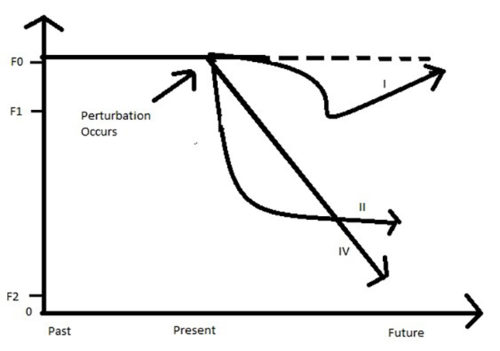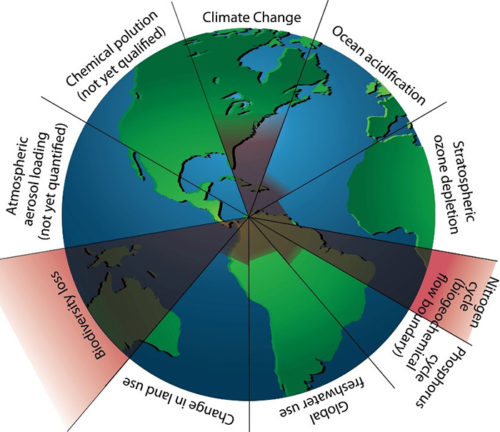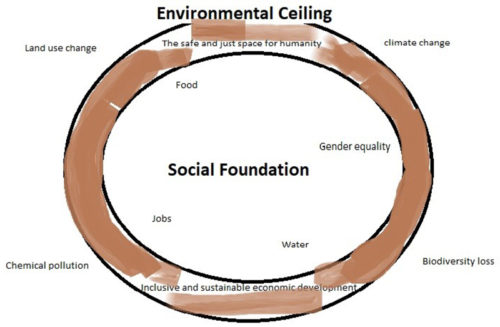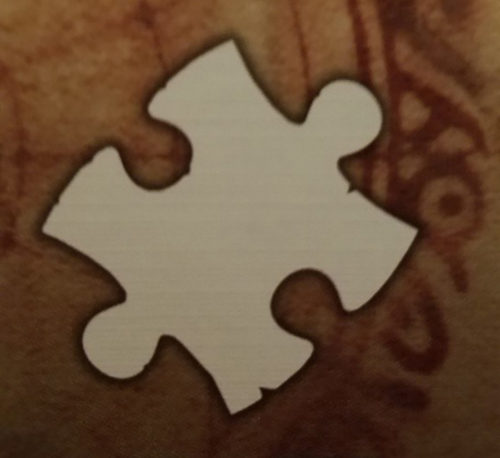“Are you watching closely?”
Isabel Sullivan ·By: Isabel Sullivan
The readings for this week were The Big Ratchet: How Humanity Thrives in the Face of Natural Crisis, by Ruth DeFries1, an excerpt from Our Common Future, produced by The United Nations2, and “A safe operating space for humanity,” by Johan Rockström et al.3. Each of these readings discusses sustainability in some form and how complicated and interconnected environmental issues are.
While reading The Big Ratchet, a movie called The Prestige4 came to mind. The Prestige is a film set in the 19th century about rivaling magicians. This film is very intricate and complex, which is why I thought it was a good way to connect and explain all the readings. The opening of the film starts with a narrator saying:
“Are you watching closely? Every magic trick consists of three parts, or acts. The first part is called the pledge. The magician shows you something ordinary: a deck of cards, a bird, or a man... The second act is called the turn. The magician takes the ordinary something and makes it do something extraordinary… making something disappear isn’t enough. You have to bring it back…the third act, the hardest part. The part we call the prestige.”4

Throughout the film, the two magicians are trying to top one another’s tricks to see who is the better magician. This creates a cycle where one magician seems to be the best but then the other tops him. When I was reading The Big Ratchet, I thought of The Prestige because of this cycle.
In The Big Ratchet , DeFries describes a cycle where the human population is ratcheted up and then some hatchet (e.g. disease) causes a steep population decline. After this decline, the people who survive figure out the cause and find a way to solve or avoid this cause. The ingenuity here can be sustainable or not for the environment. Ingenuity leads to a ratcheting up of population until the next hatchet; thus, a cycle forms1.
The ongoing cycle of human population change is similar to the consistent back and forth seen by the magicians in The Prestige. The magicians are learning from one another’s faults in order to regain fame. Additionally, the opening scene in The Prestige shows the cycle of a typical magic trick. When humans avoid a hatchet event, DeFries calls this "the pivot"1. In The Prestige, they call this "the turn"4. Each are moments where the unexpected happens; either humans engineer a way out of massive population declines by becoming sustainable or a seemingly ordinary object becomes extraordinary.
The film also goes through many unpredictable plot twists. These twists made the movie immensely complex and even after watching it many times and reading the book it was based on, I still cannot totally comprehend everything that happens. This aspect of the movie reminded me of the Rockström et al. article in which the authors discuss several planetary boundaries that should not be crossed in order to keep the environment balanced and retain sustainability. Rockström et al. note that some of the planetary boundaries, such as biodiversity loss and the Nitrogen cycle, have already been crossed and that we are dangerously close to breaching more boundaries3.
Each of the boundaries are complex and interconnected because the environment is so dynamic. Our Common Future also notes the dynamics seen in the environment. The authors at the United Nations talk about the importance of merging economic and environmental policies. They argue that people need to think of environmental problems as tied to economic problems and that environmental issues hinge on political action2. This is an additional complexity of sustainability on top of it all.
To discuss these readings and the meaning of “sustainability,” guest lecturer Dr. Xin Zhang led our class. Xin is a professor at UMCES Appalachian Laboratory who is working on biogeochemical cycles and applications of biochemicals to the agricultural community. She discussed the evolution of sustainability and asked us about our views of sustainability.
Xin started the lecture by showing us 5 ordinary objects: a line, a circle, a three-legged stool, a doughnut, and a chess board. She asked us to consider what all of the things have to do with sustainability. She was performing "the turn" in her own magic trick; turning ordinary objects into something extraordinary. Here is an account of her extraordinary transformation:
The line represents how sustainability was first described as seeking to maintain some level of resources. The Line starts at some point, then perturbation occurs (e.g. human impact) and then multiple things can happen in the future. Either the population goes back to its original levels, it declines and levels out, or it becomes extinct. This final fate of extinction is not sustainable as the resource is lost.

The circle represents the concept of planetary boundaries that Rockström et al. discuss in their article. This image provoked much discussion in class, and we talked about how the specific boundaries may be up for debate but that the image itself evokes strong emotions about the earth. The image shows us that we only have one earth and we need to be watching closely.

Xin's 3-legged stool illustration represents the 3 major components of sustainable development: economic, social, and environmental protection. These are interconnected and reinforce one another, like a stool.
A doughnut was used to explain the “safe and just space for humanity”.
Here, the outer circle is the environmental ceiling and the inner circle is the social foundation. Humans have to live within this doughnut of boundaries in order to be sustainable. It shows us that we are bound by earth’s resources and by our own social needs.

Finally, the chess board was used to show the complexity of sustainability. Xin asked us what we would define sustainability as and challenged us to draw our own interpretation. For me, I see sustainability as a puzzle piece.

Sustainability is a
puzzle that we are trying to piece together. We combine social, with
environmental, with economic theories. They all fit together but how they
connect isn’t always easy to decipher. The puzzle piece is also useful when
thinking of sustainability as a large issue that is connected to everything. We
may only understand the edges (or boundaries) of the puzzle (earth), but we are
working on figuring out the inside (human interactions with the environment).
We may find where two pieces go together in the middle, yet we still need to
connect them to the entire puzzle.
Overall, Xin was trying
to show us how the idea of sustainability evolved from a simple line into a
chess board. She magically turned everyday objects into pieces of this greater
sustainability puzzle. This extraordinary change explains how complex and intertwined
environmental issues are. Our readings this week explored the complexities of
the environment along with the complex interactions that humans have with the
environment. We all have different ideas of what specifically sustainability
means, but we all are on this planet, impacting it every day.
I challenge all of us to think about how we impact the environment on a daily basis. Do you buy local food? Do you use pesticides? Do you get plastic bags at the grocery store?
Are you paying attention to your impact? Are you
watching closely?
References:
1. DeFries, R. (2014). The big ratchet : How humanity thrives in the face of natural crisis : A biography of an ingenious species. New York, NY: Basic Books.
2. Brundtland, G. H. (1987). Our common future (Oxford paperbacks). Oxford: Oxford University Press.
3. Rockström, J., Steffen, W., Noone, K., Persson, A., Chapin, F., Lambin, E., ...Foley, J. (2009). A safe operating space for humanity. Nature, 461(7263), 472-5. doi:10.1038/461472a.
4. Thomas, E. (Producer), & Nolan, C. (Director). (2006). The Prestige [Motion Picture]. United States: Warner Bros.
About the author
Isabel Sullivan

Isabel Sullivan is a second year master’s student in the University of Maryland’s Marine Estuarine Environmental Sciences program, with a concentration in Ecological Systems. She is advised by Dr. Gerald Wilkinson studying the effect of hibernation on DNA and aging. This research is part of a larger project by Dr. Steve Horvath at UCLA working to create an epigenetic clock that can be applied to the aging and epigenetics of all mammals.
Next Post > Kicking off another semester of Environment and Society
Comments
-
Michael J. Paolisso 6 years ago
Very good summary and very effective use of images. Linking the discussion to the move "The Prestige" was an effective literary approach to hook the reader, at least me. I kept reading thinking about how you were going make connections. You did, and I don't think you diluted or mis-represented Xin's lecture and the complexity of sustainability. I see that you link ratcheting up to population increase. True for sure. I was thinking that ratcheting up included more than population. Might be worth a few minutes of class conversation. The image of Sustainability as a puzzle is effective and raises all the complex questions of how do the pieces get shaped and how do they get put together in a way that conveys an image, on the face of the puzzle. That face could represent a set of thinking about what is sustainability, and it is interesting to think and discuss what happens when you remove or reposition any particular piece or pieces. As you can see, this blog, and all the blogs to date, got me thinking more. Thanks.
-
Megan 6 years ago
This is a great synopsis of class and our readings. I'm always happy to see people re-evaluating their use. Also important to remember the most effective action we can take for the environment is voting for climate-conscious candidates!
-
Maria Rodriguez 6 years ago
Thinking of sustainability came into my mind the Greek myth of Icarus. This guy who tried to fly using wings made of wax and feathers. He flied too close to the Sun, the heat melted the wings and he drowned into the ocean. Humans use technology to “fly high”, transforming the environment to get benefit from it. But if we fly too high, surpassing the sustainable level, our technology could be not enough to save us.
-
Faith T 6 years ago
GREAT idea to incorporate some of the figures from the in class presentation into your blog post =) It is a very effective way of showing what figures you found to be important and helps convert the class material into a great blog post. Way to go.,
-
Taylor Gedeon 6 years ago
I don't use pesticides but I definitely use a lot of bug spray...am I watching closely enough?!
-
Andrea Maria Miralles-Barboza 6 years ago
I wonder if we are pieces of the puzzle or if we are the ones trying to piece them together? Perhaps both?
Loved this concept!!
-
Amanda Rockler 6 years ago
Great post. I really enjoyed the movie thread that wove the readings and classwork together. I try and pay attention, but I also feel like it is hard to live in our world today and always make the most sustainable decisions (plastic is everywhere!). Recycling today is a great example. Once China purchased most of our recyclables. Now that that is no longer happening, what do we do? I still recycle, I still hope it gets recycled, but in reality it may end up going to the landfill. It is important, but hard to always pay attention. I just try my best, day after day.
-
Enid Munoz 6 years ago
Excellent summary of the class. It really puts a person's day to day life into perspective of what changes here and there we can do to positively impact our environment.
-
Kayle K. 6 years ago
Thanks for this great overview of our class discussion on sustainability. This was by far my favorite approach we have discussed so far. I appreciate Megan’s comment reminding us to vote for climate conscious candidate. And considering the response to the Climate Strike last week, it looks like many people are interested in effective action! The Prestige looks like an interesting movie, it will go on my “to view” list.
-
Alison Thieme 6 years ago
I like the puzzle piece imagery in trying to describe sustainability. It can be tied back to DeFries' idea of a pivot when we fit a piece of the puzzle in a place it may not belong. We then can build off of that puzzle piece for a while (ratchet) and then reevaluate when the pieces stop fitting (hatchet).
I think the challenge is developing policies and technologies (puzzle pieces) and then adopting them into society (putting them together); a process that can take several missteps to get right.
-
Xin Zhang 6 years ago
I really like to the puzzle piece idea. It shows the complexity of sustainability: many concerns of sustainability are connected, some are in synergies while others on in trade-offs (those concepts have been elaborated in the optional reading material which we did not have time to discuss); and we are still at the early stage in putting together the puzzles. We can also think ourselves as the pieces of the puzzle, and the action from each of us counts! we need to work together to achieve sustainability goals.
Good job in summarizing the class! -
Hamani Wilson 6 years ago
i love the concept of the needs ans sustainability donuts. I am also a big fan of "Chess" and the multitude of option or directions that we can take to respond to the needs and challenges present by our changing planet. Great analogy.

